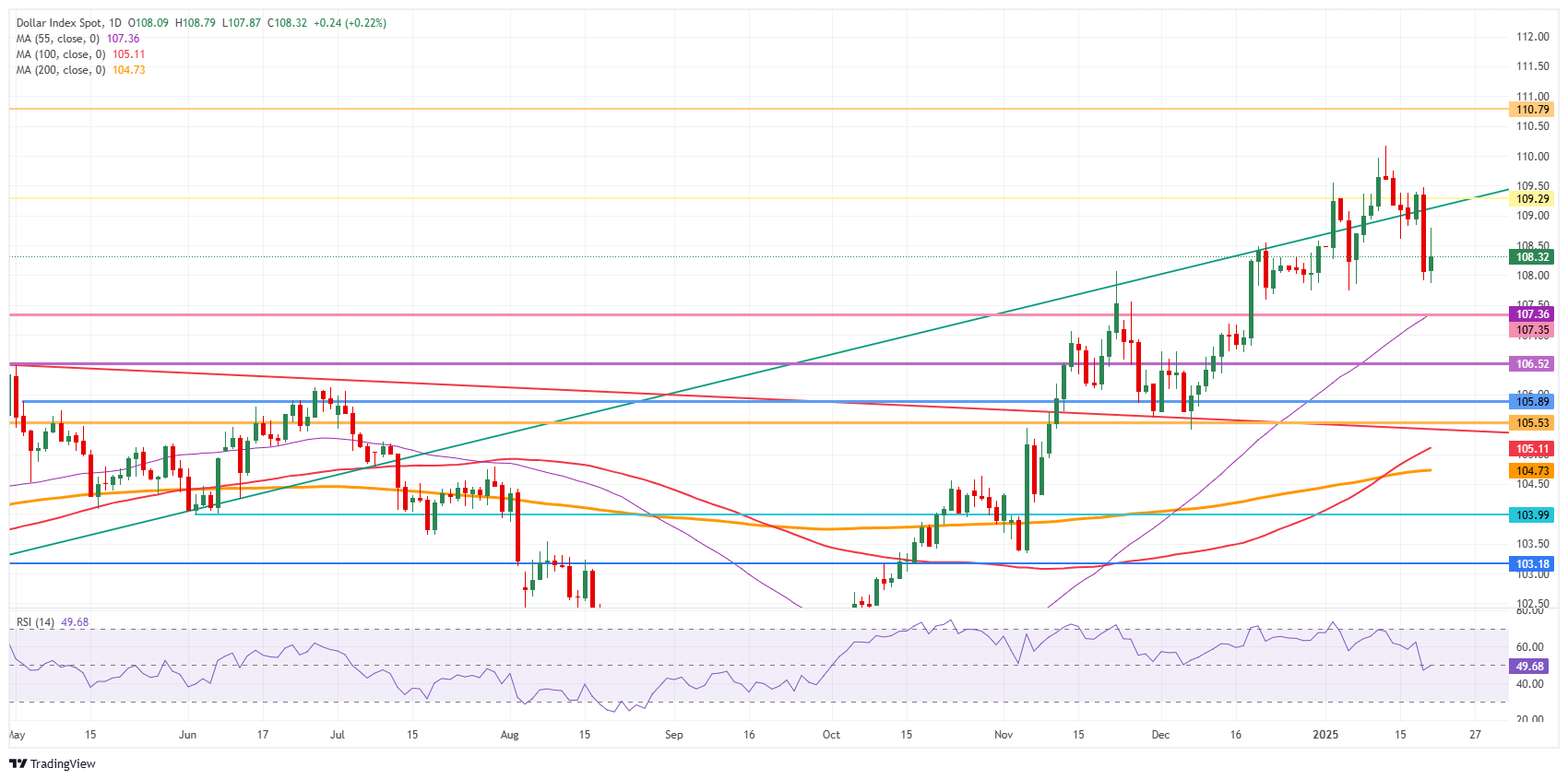- The US dollar sees its previous recovery attempts wiped out ahead of US spot trading.
- Traders are considering President Trump’s upcoming comments and announcements.
- The US Dollar Index (DXY) is trading just above 108.00 and could see losses if more selling pressure is felt.
The U.S. Dollar Index (DXY), which tracks the value of the greenback against six major currencies, sees its previous attempts to recover from Monday’s poor performance erased ahead of new comments from President Donald Trump, who is about to make an announcement on infrastructure. The US dollar received a sharp correction on Monday, losing more than 1% of the index, when it emerged that tariffs were not part of the executive orders signed by Donald Trump during his first hours as president. as American president. Markets got off on the wrong foot thinking that the tariff stance had been eased and would face a significant delay.
However, a surprise comment from US President Trump on Monday evening sparked a turnaround with reversals in all major pairs, including the US dollar. President Trump said 25% tariffs on imports from Canada (CAD) and Mexico (MXN) would be expected in early February, with a devaluation of the Canadian dollar (CAD) and Mexican peso (MXN) in immediate reaction. Overall, reversals are taking place on Tuesday from Monday’s losses on almost every front and asset class affected by these comments.
Developments in the daily summary market: a bumpy road ahead
- The US Treasury will release some data this Tuesday in an otherwise very empty economic calendar. At 4:30 p.m. GMT, 3-month, 6-month and 52-week bonds will be allocated on the markets.
- Stocks align with Tuesday’s gains. European stocks are flat, while U.S. futures are up almost 0.50%.
- The CME FedWatch tool projects a 54.2% chance that interest rates will remain unchanged at current levels at the May meeting, suggesting a rate cut in June. The Federal Reserve (Fed) is expected to remain data-dependent, with uncertainties potentially influencing inflation during US President Donald Trump’s term.
- The US 10-year yield is trading around 4.57% and still has a long way to go if it is to return to last week’s levels, near 4.75%.
US Dollar Index Technical Analysis: Recovery is underway
The US Dollar Index (DXY) fell into the hands of the bears on Monday, and the bulls regained the upper hand on Tuesday. However, traders should be aware of some potholes in the road if DXY returns to 109.00 and above. With the rally underway on Tuesday, some crucial upside levels could cause a significant rejection, leading to a catastrophic rebound, trapping US dollar buyers and pushing them towards 107.00 and lower.
If this recovery wants to continue its ascent, the pivot level to control is 109.29 (July 14, 2022, high and ascending trendline). Higher, the next significant upside level to reach before advancing further remains at 110.79 (September 7, 2022 high). Once beyond there, it’s a long way to 113.91, an October 2022 double top.
On the downside, the first area to watch is 107.85-107.90, which contains Monday’s correction. Further down, the convergence of the October 3, 2023 high and the 55-day simple moving average (SMA) around 107.35 should act as a double safety net to catch any falling knives.

US Dollar Index: Daily Chart
Inflation FAQ
Inflation measures the increase in the price of a representative basket of goods and services. Headline inflation is usually expressed as a percentage change on a monthly (MoM) and annual (YoY) basis. Core inflation excludes more volatile items such as food and fuel, which can fluctuate due to geopolitical and seasonal factors. Core inflation is the number that economists focus on and it is the level targeted by central banks, which have a mandate to keep inflation at a manageable level, usually around 2%.
The consumer price index (CPI) measures the change in prices of a basket of goods and services over a given period. It is usually expressed as a percentage change on a monthly (MoM) and annual (YoY) basis. The core CPI is the figure targeted by central banks because it excludes volatile food and energy intakes. When the core CPI exceeds 2%, it generally leads to higher interest rates and vice versa when it falls below 2%. Since higher interest rates are positive for a currency, higher inflation generally results in a stronger currency. The opposite is true when inflation falls.
Although it may seem counterintuitive, high inflation in a country causes the value of its currency to rise and vice versa, lower inflation. This is because the central bank normally raises interest rates to combat rising inflation, attracting more global capital inflows from investors looking for a lucrative place to park their money.
Previously, gold was the asset that investors turned to during times of high inflation because it preserved its value, and although investors still often buy gold for its safe haven properties in times of extreme market turmoil, markets, this is not the case most of the time. . Indeed, when inflation is high, central banks increase interest rates to combat it. Higher interest rates are negative for gold because they increase the opportunity cost of holding gold relative to an interest-bearing asset or placing the money in a cash deposit account. On the other hand, a decline in inflation tends to be positive for gold as it lowers interest rates, making this shiny metal a more viable investment alternative.


